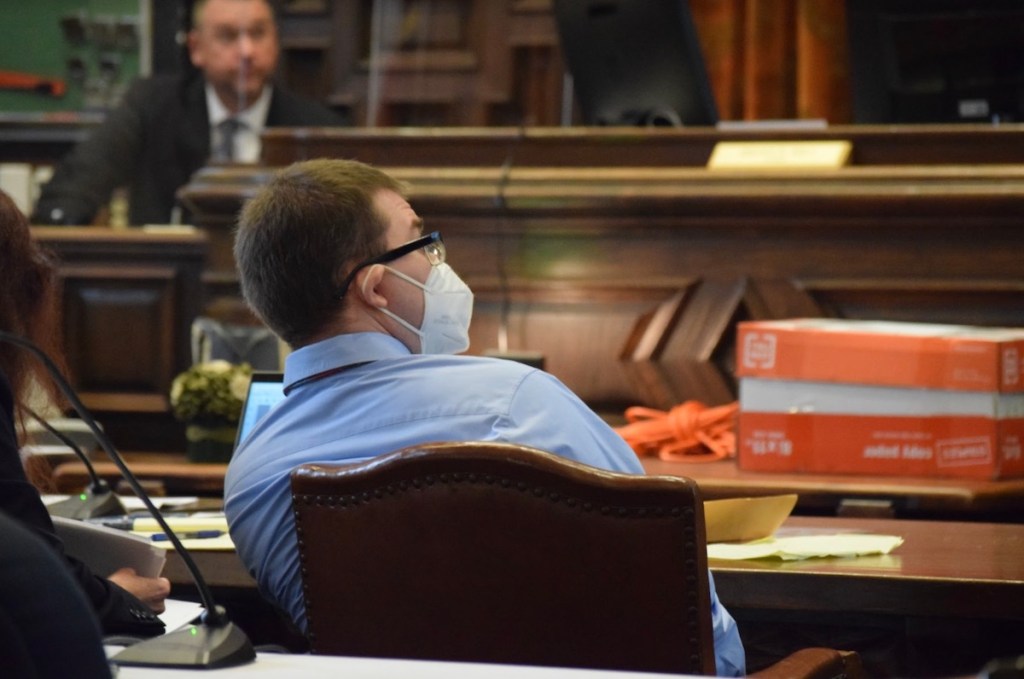Pierre Haobsh squirmed in Judge Bran Hill’s courtroom as his personal web history was blasted onto the screen, serving as a window into his mind on the days leading up to and following the murders of renowned Santa Barbara herbalist Dr. Henry Han; his wife, Jennie Yu; and their 5-year-old daughter, Emily Han. The information was recovered from a cell phone and laptop found in his possession when he was arrested in 2016.
The prosecution has been calling its final witnesses in the trial against Haobsh, who is accused of killing all three victims and attempting to use Han’s personal information to transfer $77,000 to his own bank account.
The state’s evidence against Haobsh has been overwhelming thus far — there was the testimony from Haobsh’s friend Thomas “TJ” Direda, who reported Haobsh as a suspect to authorities; there was physical evidence tying his fingerprints to the plastic sheeting and duct tape used to wrap the bodies, as well as surveillance footage of him purchasing the same items at Home Depot; and there was a four-hour interrogation video that showed Haobsh skirting the detectives’ questions and denying his involvement in the crime.
On Friday and Monday, investigators Travis Henderson and Jeff Ellis walked prosecutors Hilary Dozer and Benjamin Ladinig through the web history from an iPhone and HP laptop found in Haobsh’s possession, and security footage and receipts showing where he was while he was allegedly planning the crime using his mobile devices.
According to witness testimony and text message records, investigators found that Haobsh had signed a “memorandum of understanding” with Han to create a company called Obsidian Teradyne the day before the killings. In it, Haobsh promised to provide $15 million to help create the company, although bank records showed he was worth less than $500 at the time. Haobsh told detectives he didn’t have the money personally but “knew” people who would provide the financial backing. In texts to Han, Haobsh boasts that he was close to being a billionaire, with a lavish lifestyle with gambling, women, Lamborghinis, and private jets.
Prosecutors showed that Haobsh installed spyware on his own laptop as a “dry run” before installing the same software on Han’s home computer days before the murders. It serves as a step-by-step retelling of how Haobsh allegedly attempted to transfer $72,000 into his personal bank account, even creating a fake email address to receive verification codes meant for Han.
Haobsh’s defense team of Christine Voss and Michael Hanley contend that investigators failed to conduct follow-up interviews and chase leads that may have led to other suspects. Voss objected to any reference to Haobsh as the man beyond the computer, maintaining that the items found in his car could have been planted there.
Sign up for Indy Today to receive fresh news from Independent.com, in your inbox, every morning.
Detective Ellis testified that cell phone records showed Haobsh’s cell phone being used at El Capitan State Beach from 4 p.m. to around 7:30 p.m. on March 21, 2016, the same day he had used the spyware to obtain Han’s information. His web browser history from that time shows searches for a number of topics from “the legal amount of cash you can carry on an international flight” to “what kind of gun used by James Bond.”
The cell phone history shows searches about guns and ammunition — first a Walther PPK with .380 ACP bullets, then eventually settling on a Ruger MKII with .22 LR ammo. There is a visit to an online database that shows guns featured in movies and television. Earlier evidence showed Haobsh purchased a Ruger .22 pistol at an Arizona gun shop, the same model used in the murders.
In the parking lot at El Capitán, Ellis said, Haobsh watched videos of suppressed pistols before searching for local movie listings: Kung Fu Panda, Allegiant, and 10 Cloverfield Lane. He planned to see a movie at Camino Real Cinemas later that night.
The day after the murders, similar evidence shows Haobsh in a Thousand Oaks McDonald’s parking lot where, the prosecution contends, Haobsh used his laptop to gain access to Han’s Chase and Wells Fargo bank accounts and attempted multiple times to transfer money into his own account. Eventually, he was able to transfer $5,000.
Web searches showed a range of questions were sought: “How good are fingerprint forensics?” “How long does crime scene analysis take?” “Is a car searched entering Tijuana?”
There is even a chat with an online psychic, a “master of cartomancy” by the name of Count Marco who charges $3.95 per minute. The user, using the name “Pierre,” chats with the Count. The computer’s spyware allowed investigators to read every keystroke.
“I have done bad things,” “Pierre” types, before changing his mind and deleting the message, instead sending: “I have made bad choices.”
“Unforgivable,” he types again before deleting.
He asks Count Marco: “Will I get caught for what I did?”
In the courtroom, Haobsh rewatched all these moments played out on the large screen in Department 2 of Santa Barbara Superior Court. The defense will lay out its case next week, though it is still undecided whether Haobsh will take the stand. Since both sides agreed to waive a jury trial, Judge Hill alone will decide Haobsh’s fate once both sides make closing statements, as expected next week.
Support the Santa Barbara Independent through a long-term or a single contribution.

